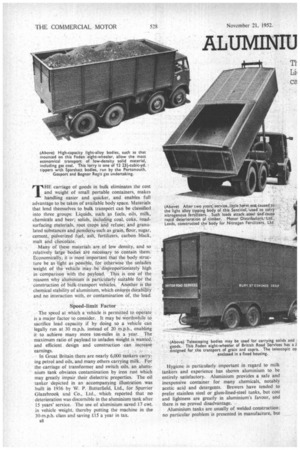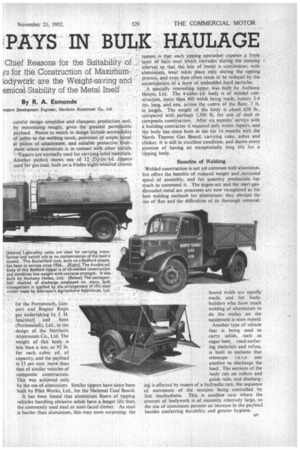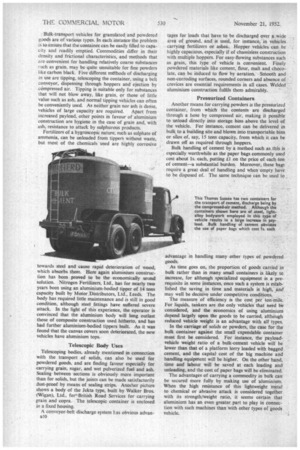ALUMINIU PAYS IN BULK HAULAGE
Page 42

Page 43

Page 44

If you've noticed an error in this article please click here to report it so we can fix it.
By R. A. Esmonde
msport Development Engineer, Northern Aluminium Co., Ltd.
THE carriage of .goods in bulk eliminates the cost and weight of small portable containers, makes handling easier and quicker, and enables full advantage to be taken of available body space. Materials that lend themselves to bulk transport can be classified into three groups: Liquids, such as fuels, oils, milk, chemicals and beer; solids, including coal, coke, roadsurfacing materials, root crops and refuse; and granulated substances and powders i such as grain, flour, sugar, cement,. pulverized file], ash, fertilizers, carbon black,
malt and chocolate. .
Many of these materials are of low density, and so relatively large bodieS are necessary to contain them. Economically, it is most important that the body structure be as light as possible, for Otherwise the unladen weight of the -vehicle may be" disproportionately high in comparison 'with the payload. 'This is one of the reasons why aluminium is particUlarly suitable fOr the construction Of bulk-transport vehicles. ' Another is the chemical stability of aluminium, which ensures durabilitY and no interaction with, or contamination of, the load.
Speed-limit Factor The speed at which a vehicle is permitted to operate is a major factor to consider. It may be Worthwhile to, sacrifice load capacity if by doing so a vehicle can legally run at 30 m.p.h. instead of 20 M.p.h., enabling it to achieve many more ton-miles in a year. The maximum ratio of payload to unladen weight is wanted, and efficient design and construction can increase earnings, In Great Britain there are nearly 6,000 tankers carrying petrol and oils, and many others carrying milk. For the carriage of transformer and switch oils, an aluminium tank obviates contamination by iron rust which may greatly impair their dielectric properties. The oil tanker depicted in an accompanying illustration was built in 1936 by W. P. Butterfield, Ltd., for Spurrier Glazebrook and Co., Ltd., which reported that no deterioration was discernible in the aluminium tank after 15 years' service. The use of aluminium saved 17 cwt. in vehicle weight, thereby putting the machine in the 30-m.p.h. class and saving £15 a year in tax.
DS Hygiene is particularly important in regard to milk tankers and experience has shown aluminium to be entirely satisfactory. Aluminium provides a safe and inexpensive container for many chemicals, notably acetic acid and detergents. Brewers have tended to prefer stainless steel or glass-lined-steel tanks, but cost and lightness are greatly in aluminium's favour, and there is no proved disadvantage.
Aluminium tanks are usually of welded construction; no particular problem is presented in manufacture, but
careful design simplifies and cheapens production and, by minimizing • weight, gives the greatest permissible payload. Points to watch in design 'include accessibility of jtiitits to the-welding torch, provision of ample Metal 'ci.oints of attachment, and suitable protective treatfiled:Where aluminium is in contact with other metals. --Tippers att normally used for earl-king 'Solid 'materials. Another picture shows one of :12.-231-ctr.-Srd. .tippers used for gas'coal, built on a Foden tight-wheeled chassis for the Portsmouth, Gosport and Bognor Regis gas undertaking by J. H. Spdrshati and Sons (Portsmouth), Ltd., to the design of the Northern Aluminium Co., Ltd. The weight of this body is leis than a ton, or 92 lb. for each cubic yd. of capacity, and the payload is 13 per cent. more than that of similar vehicles of composite construction. This was achieved only by the use of aluminium. Similar tippers have since been built by Pilot Works, Ltd., for the National Coal Board.
It has been found that aluminium floors of tipping vehicles handling abrasive solids have a longer life than the commonly used steel or steel-faced timber. As steel is harder than aluminium, this may seem surprising: the
rpason is that each tipping operation exposes a fresh Liver of bare steel which corrodes during the ensuing interval ,so that the loss of -metal is continuous; with aluminium, wear takes place only during the tipping process, and even then often tends to be reduced by the accumulation of a layer of embedded hard' particles.
A specially interesting tipper was built by Anthony Hoists; Ltd. The 4-cubic-yd. body is of -welded construction, more than 400 welds. being made, -mostly 2-4 ins: long, and one, across the centre of the floor, 7 ft.. in length. The weight of the body is about 650 lb.. compared with perhaps 1,560 lb. for one of steel or composite construction. After six months' service with a building contractor it required only minor repairs, and the body has since been in use for 14 months with the North Thames Gas Board, carrying coke, ashes' and clinker. It is still in excellent condition, and shows every promise of having an exceptionally long life for a lipping body.
Benefits of Welding Welded construction is not yet common with aluminiun. but offers the benefits of reduced weight and increased speed of assembly, and for quantity production has much to commend it. The argon-arc and the inert-gasshrouded,metal arc processes are now recognized as the best welding methods for aluminium; they obviate the use of flux and the difficulties of its thorough removal.
Sound welds are rapidly made, and for bodybuilders who have much welding of aluminium to do the outlay on the equipment is soonrepaid.
Another type of vehicle that is being used to carry solids, such as sugar-beet, road-surfacing materials and refuse, is built in sections that telescope into one another to discharge the load. The sections of the body run on rollers and guide rails, and discharging is effected by means of a hydraulic' ram, the sequence of. movement of the sections being controlled by link mechartisms. This is, another case where the amount of bodywork is of necessity, relatively large, so the use of aluminium permits an increase in the payload besides conferring durability and greater hygiene.
Bulk-transport vehicles for granulated and powdered goods are of various types. In each instance the problem is to ensure that the container can be easily filled to capacity and readily emptied. Commodities differ in their density and frictional characteristics, and methods that are convenient for handling relatively coarse substances ,.uch as grain, may be quite unsuitable for fine powders like carbon black. Five different methods of discharging in use are tipping, telescoping the container, using a belt conveyor, dispensing through hoppers and ejection by compressed air. Tipping is suitable only for substances that will not blow away, like grain, or those of little value such as ash, and normal tipping vehicles can often be conveniently used. As neither grain nor ash is dense,
vehicles of large capacity are required. Apart from increased payload, other points in favour of aluminium construction are hygiene in the case of grain and, with ash, resistance to attack by sulphurous products.
Fertilizers of a hygroscopic nature, such as sulphate of ammonia, can be unloaded from tippers without waste, but most of the chemicals used are highly corrosive
towards steel and cause rapid deterioration of wood, which absorbs them. Here again aluminium construction has been proved to be the economically sound solution. Nitrogen Fertilizers, Ltd., has for nearly two years been using an aluminium-bodied tipper of 14 tons capacity built by Motor.Distributors, Ltd., Leeds. The body has required little maintenance and is still in good condition, although steel fittings have suffered severe attack. In the light of this experience, the operator is convinced that the aluminium body will long outlast those of composite construction used hitherto, and has had further aluminium-bodied tippers built. As it was found that the canvas covers soon deteriorated, the new vehicles have aluminium tops.
Telescopic Body Uses Telescoping bodies, already mentioned in connection with the transport of solids, can also be used for powdered goods, and are finding favour especially for carrying grain, sugar, and wet pulverized fuel and ash. Sealing between sections is obviously more important than for solids, but the joints can be made satisfactorily dust-proof by means of sealing strips. Another picture shows a body of the Jekta type, built by Walker Bros. (Wigan), Ltd., for' British Road Services for carrying grain and copra. The telescopic container is enclosed in a fixed housing.
A conveyor-belt discharge system Las obvious advanrit0
tages for loads that have to be discharged over a wide area of ground, and is used, for instance, in vehicles carrying fertilizers or ashes.. Hopper vehicles can be highly capacious, especially if of chassisless construction with multiple hoppers. For easy-flowing substances such as grain, this type of vehicle is convenient. Finely powdered materials like cement, flour, malt and chocolate, can be induced to flow by aeration. Smooth and non-corroding surfaces, rounded corners and absence of crevices are essential requirements in all cases. Welded aluminium construction fulfils them admirably.
Pressurized Containers Another means for carrying powders is the pressurized container, from which the contents are discharged through a hose by compressed air, making it possible to unload directly into storage bins above the level of the vehicle. For instance, cement can be delivered in bulk to a building site and blown into transportable bins or silos of, say, 15 tons capacity, from which it can be drawn off as required through hoppers.
Bulk handling of cement by a method such as this is especially worthwhile as the paper bags commonly used cost about Is. each, putting £1 on the price of each ton of cement—a substantial burden. Moreover, these bag require a great deal of handling and when empty have to be disposed of. The same technique can be used to
advantage in handling many other types of powdered goods.
As time goes on, the proportion of goods carried in bulk rather than in many small containers is likely to increase, for although specialized equipment is a prerequisite in some instances, once such a system is estab. lished the saving. in time and materials is high, and may well be decisive under competitive conditions.
The measure of efficiency is the cost per ton-mile. For liquids, tankers are the only vehicles that need be considered, and the economics of using aluminium depend largely upon the goods to be carried, although reduced vehicle weight is an advantage with all types.
In the carriage of solids or powders, the case for the bulk container against the small expendable container must first be considered. For instance, the payloadvehicle weight ratio of a bulk-cement vehicle will be lower than that of a platform lorry loaded with bagged cement, and the capital cost of the big machine and handling equipment will be higher. On the other hand, time and labour will be saved at each loading and unloading, and the cost of paper bags will be eliminated.
The advantages of carrying a commodity in bulk can be secured more fully by making use of -aluminium. When the high resistance of this lightweight metal to chemical or abrasive attack is considered together with its strength/weight ratio, it seems certain that aluminium has an even greater part to play in connection with such machines than with other types of goods vehicle.




















































































